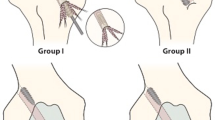Abstract
There has never been an MRI study of tunnel widening comparing bioabsorbable to metal screw fixation in autologous hamstring anterior cruciate ligament (ACL) reconstruction. We randomized 62 patients to hamstring ACL reconstruction with either a bioabsorbable (n = 31) or metal screw (n = 31) fixation. The evaluation methods were clinical examination, KT-1000 arthrometric measurement, the International Knee Documentation Committee and Lysholm scores, and MRI. There were no differences between the groups preoperatively. Fifty-five patients (89%) were available at a minimum of 2-year follow-up (range 24–36 months). There was tunnel widening in both groups, but the increase was significantly greater in the AP dimension of the femoral tunnel in the bioabsorbable screw group compared to metal group (P = 0.01). The tibial tunnels showed no intergroup difference. Ninety-four percent of the knees were normal or nearly normal according to the IKDC scores and the average Lysholm score was 91 with no intergroup difference. The follow-up AP tibial tunnel diameter was smaller with normal knee laxity compared to abnormal knee laxity. The graft failure rate in the bioabsorbable screw group was 23% (7/31 patients) and 6% (2/31 patients) in the metal screw group. The use of bioabsorbable screws resulted in more femoral tunnel widening, and more graft failures compared to metal screws. The tunnel widening in the tibia was associated with the knee laxity (P = 0.02).




Similar content being viewed by others
References
Barber A, Dockery D (2006) Long-term absorption of poly-l-lactic acid interference screws. Arthroscopy 22:820–826
Böstman O, Pihlajamäki H (2000) Adverse tissue reactions to bioabsorbable fixation devices. Clin Orthop Relat Res 371:216–227
Daniel DM, Malcom LL, Losse G, Stone ML, Sachs R, Burks R (1985) Instrumented measurement of anterior laxity of the knee. J Bone Joint Surg Am 67:720–726
Fules P, Madhav R, Goddard R, Newman-Sanders A, Mowbray M (2003) Evaluation of tibial bone tunnel enlargement using MRI scan cross-sectional area measurement after autologous hamstring tendon ACL replacement. Knee 10:87–91
Hefti F, Müller W, Jakob RP, Staubli HU (1993) Evaluation of knee ligament injuries with the IKDC form. Knee Surg Sports Traumatol Arthrosc 1:226–234
Höher J, Möller HD, Fu FH (1998) Bone tunnel enlargement after anterior cruciate ligament reconstruction: fact or fiction? Knee Surg Sports Traumatol Arthrosc 6:231–240
Järvelä T, Nurmi JT, Paakkala A, Moisala AS, Kaikkonen A, Järvinen M (2007) Improving biodegradable interference screw properties by combining polymers. In: Prodromos. The anterior cruciate ligament. Reconstruction and basic science. Elsevier, Amsterdam
Lajtai G, Noszian I, Humer K, Unger F, Aitzetmüller G, Orthner E (1999) Serial magnetic resonance imaging evaluation of operative site after fixation of patellar tendon graft with bioabsorbable interference screws in anterior cruciate ligament reconstruction. Arthroscopy 15:709–718
Lajtai G, Schmiedhuber G, Unger F, Aitzetmüller G, Klein M, Noszian I, Orthner E (2001) Bone tunnel remodeling at the site of biodegradable interference screws used for anterior cruciate ligament reconstruction: 5-year follow-up. Arthroscopy 17:597–602
Laxdal G, Kartus J, Eriksson B, Faxén E, Sernert N, Karlsson J (2006) Biodegradable and metallic interference screws in anterior cruciate ligament reconstruction surgery using hamstring tendon grafts. Prospective randomized study of radiographic results and clinical outcome. Am J Sports Med 34:1574–1580
Lysholm J, Gillquist J (1982) Evaluation of knee ligament surgery results with special emphasis on use of scoring scale. Am J Sports Med 10:150–154
Ma CB, Francis K, Towers J, Irrgang J, Fu FH, Harner CH (2004) Hamstring anterior cruciate ligament reconstruction: a comparison of bioabsorbable interference screw and endobutton-post fixation. Arthroscopy 20:122–128
Maletis G, Cameron S, Tengan J, Burchette R (2007) A prospective randomized study of anterior cruciate ligament reconstruction. A comparison of patellar tendon and quadruple-strand semitendinosus/gracilis tendons fixed with bioabsorbable interference screws. Am J Sports Med 35:384–394
Peyrache M, Djian P, Christel P, Witvoet J (1996) Tibial tunnel enlargement after anterior cruciate ligament reconstruction by autogenous bone-patellar tendon-bone graft. Knee Surg Sports Traumatol Arthrosc 4:2–8
Pinczewski LA, Deehan DJ, Salmon LJ, Russell VJ, Clingeleffer A (2002) A five-year comparison of patellar tendon versus four-strand hamstring tendon autograft for arthroscopic reconstruction of the anterior cruciate ligament. Am J Sports Med 30:523–536
Pinczweski L, Lyman J, Salmon L, Russell V, Roe J, Linklater J (2007) A 10-year comparison of anterior cruciate ligament reconstructions with hamstring tendon and patellar tendon autograft: a controlled, prospective trial. Am J Sports Med 35:564–574
Robinson J, Huber C, Jaraj P, Colombet P, Allard M, Meyer P (2006) Reduced bone tunnel enlargement post hamstring ACL reconstruction with poly-l-lactic acid/hydroxyapatite bioabsorbable screws. Knee 13:127–131
Sanders TG, Tall MA, Mulloy JP, Leis HT (2002) Fluid collections in the osseous tunnel during the first year after anterior cruciate ligament repair using an autologous hamstring graft: natural history and clinical correlation. J Comput Assist Tomogr 26:617–621
Wilson TC, Kantaras A, Atay A, Johnson DL (2004) Tunnel enlargement after anterior cruciate ligament surgery. Am J Sports Med 32:543–549
Acknowledgments
The authors wish to thank Heini Huhtala (MSc) for the statistical help. The study was financially supported by the Medical Research Fund of Tampere University Hospital and the National Graduate School of Clinical Investigation. The study sponsors had no involvement in the actual implementation of the study.
Author information
Authors and Affiliations
Corresponding author
Rights and permissions
About this article
Cite this article
Moisala, AS., Järvelä, T., Paakkala, A. et al. Comparison of the bioabsorbable and metal screw fixation after ACL reconstruction with a hamstring autograft in MRI and clinical outcome: a prospective randomized study. Knee Surg Sports Traumatol Arthr 16, 1080–1086 (2008). https://doi.org/10.1007/s00167-008-0593-z
Received:
Accepted:
Published:
Issue Date:
DOI: https://doi.org/10.1007/s00167-008-0593-z




